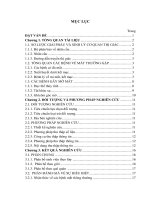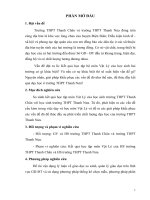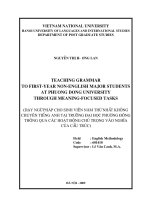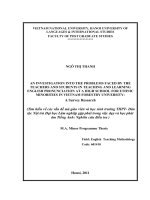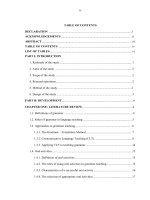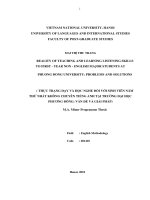Những vấn đề gặp phải trong việc dạy và học kỹ năng nghe hiểu tiếng Anh của giảng viên và sinh viên năm thữ nhất không chuyên tại trường đại học Sao Đỏ và một s
Bạn đang xem bản rút gọn của tài liệu. Xem và tải ngay bản đầy đủ của tài liệu tại đây (1.2 MB, 62 trang )
VIETNAM NATIONAL UNIVERSITY, HANOI
UNIVERSITY OF LANGUAGES AND INTERNATIONAL STUDIES
FACULTY OF POST-GRADUATE STUDIES
________________
TĂNG THỊ HỒNG MINH
THE PROBLEMS FACED BY TEACHERS AND FIRST YEAR
NON – ENGLISH MAJOR STUDENTS AT SAO DO UNIVERSITY
IN TEACHING AND LEARNING ENGLISH LISTENING SKILL AND
SOME SOLUTIONS
(NHỮNG VẤN ĐỀ GẶP PHẢI TRONG VIỆC DẠY VÀ HỌC KỸ NĂNG
NGHE HIỂU TIẾNG ANH CỦA GIẢNG VIÊN VÀ SINH VIÊN NĂM
THỨ NHẤT KHÔNG CHUYÊN TẠI TRƯỜNG ĐẠI HỌC SAO ĐỎ VÀ
MỘT SỐ GIẢI PHÁP KHẮC PHỤC)
M.A. MINOR THESIS
Field: English Teaching Methodology
Code: 6014.0111
HANOI – 2013
VIETNAM NATIONAL UNIVERSITY, HANOI
UNIVERSITY OF LANGUAGES AND INTERNATIONAL STUDIES
FACULTY OF POST-GRADUATE STUDIES
________________
TĂNG THỊ HỒNG MINH
THE PROBLEMS FACED BY TEACHERS AND FIRST YEAR
NON – ENGLISH MAJOR STUDENTS AT SAO DO UNIVERSITY
IN TEACHING AND LEARNING ENGLISH LISTENING SKILL AND
SOME SOLUTIONS
(NHỮNG VẤN ĐỀ GẶP PHẢI TRONG VIỆC DẠY VÀ HỌC KỸ NĂNG
NGHE HIỂU TIẾNG ANH CỦA GIẢNG VIÊN VÀ SINH VIÊN NĂM
THỨ NHẤT KHÔNG CHUYÊN TẠI TRƯỜNG ĐẠI HỌC SAO ĐỎ VÀ
MỘT SỐ GIẢI PHÁP KHẮC PHỤC)
M.A. MINOR THESIS
Field: English Teaching Methodology
Code: 6014.0111
Supervisor: Dr. Duong Thi Nu
HANOI – 2013
i
DECLARATION
I certify that this thesis is the result of my own study and that it has not been
submitted to any other university or institution wholly or partially.
Hanoi, September 2013
Student
Tăng Thị Hồng Minh
ii
ACKNOWLEDGEMENTS
First of all, I would like to express my sincere thanks to my supervisor, Dr.
Dương Thị Nụ from Faculty of English Language Teacher Education, University of
Languages International Studies for her precious advices, insightful comments,
patient guidance, criticism, corrections and support throughout my research.
Without her help, this thesis would not have been accomplished.
I would also like to thank all the lecturers of the Department of Post Graduate
Studies, University of Languages International Studies for their useful lectures and
materials which are of great values to my thesis.
I am also grateful to my colleagues, the non-English freshmen at Sao Do
University for their assistance and valuable information during the process of
preparing this research.
Finally, I wish to thank all the support and encouragement of my family in time
of difficulty and frustration.
iii
ABSTRACT
Listening plays an important role in communication as it is said that, of the
total time spent on communicating, listening takes up 40-50%; speaking, 25-30%;
reading, 11-16%; and writing, about 9% (Mendelsohn, 1994. This study attempt to
present listening comprehension problems encountered by lecturers and first-year
students at Sao Do University at the same time pointing out the factors affecting
learners‟ difficulties and the listening teaching difficulties. The thesis is based on
data collected from survey questionnaires. One hundred students and fifteen
lecturers at Sao Do University have taken part in this study. In addition, interviews
and class observation were applied as well to enhance the reliability and validity of
the study. The results showed that learners encountered various kinds of listening
problems which were divided into four categories: students‟ linguistic difficulties in
learning listening, students‟ listening difficulties related to the listening text, factors
related to the speakers, and factors related to the listeners. From the findings of the
research, some recommendations were presented to help them overcome the
difficulties in learning and teaching.
iv
TABLE OF CONTENTS
PART I: INTRODUCTION 1
1. Rationale 1
2. Aims of the study 1
3. Research Question 2
4. Scope of the study 2
5. Significance of the study 2
6. Methods of the study 3
7. Design of the study 3
PART II: THE DEVELOPMENT 5
CHAPTER 1: LITERATURE REVIEW 5
1.1 Theoretical background of listening 5
1.2. Potential problems in learning and teaching listening 8
1.3 Previous studies on listening difficulties in Vietnam 12
1.4 Summary 13
CHAPTER 2: RESEARCH METHODOLOGY 15
2.1 The setting of the study 15
2.2 Participants 15
2.3 Data collection instruments 16
CHAPTER 3: THE STUDY 18
3.1 Survey questionaires 18
3.2 Interview 28
3.3 Class observation 30
v
CHAPTER 4: FINDINGS AND RECOMMENDTATIONS 32
4.1 Findings 32
4.2 Recommendation 35
PART III: CONCLUSION 40
REFERENCE 42
APPENDICES I
APPENDIX 1 I
APPENDIX 2 IV
APPENDIX 3 VI
APPENDIX 4 IX
INTERVIEW QUESTIONS FOR TEACHERS IX
APPENDIX 5 X
vi
TABLE OF CHARTS
Chart 1. Learners‟ perceptions of listening difficulties related to listening text
Chart 2a. Learners‟ perceptions of their linguistic difficulties in learning listening
Chart 2b. Learners‟ perceptions of learning difficulties related to listeners
Chart 3: Learners‟ perceptions of their listening difficulties related to the speakers
Chart 4. Learners‟ perceptions of their listening difficulties related to the listening
environment
Chart 5. Teachers‟ assessment of listening task in the textbook
Chart 6. Teachers‟ perception of students‟ attitudes towards listening lessons
Chart 7. Learners‟ expectations towards their teachers and teachers‟ opinions about
how can help their students
1
PART I: INTRODUCTION
1. Rationale
It cannot be denied that learning and teaching English in Vietnam has gained a
considerable improvement recently especially after Vietnam„s participation into
WTO. The demand for English communicative proficiency is rising compared to
that in the past. While learning grammar and vocabulary were prioritized in the past,
it is not the case at present. In recent years, communicational skills such as listening
and speaking skills have been paid more attentions since they are the major key to
international communication. Therefore, students‟ communicative competence has
been stressed. At Sao Do University (SDU), as most other universities in Vietnam,
communicative approach has been more and more applied in teaching and learning
English; However, despite the teachers‟ and students‟ efforts, the students
especially the non-English major freshmen often have a lot of difficulties in
learning listening comprehension. Most of students find listening so challenging for
them to learn well while teachers find it so difficult to motivate students, make them
eager and interested in listening lessons. After careful observation and practical
teaching, I realized that the reasons for this situation seem to be popular to
Vietnamese students such as lack of vocabulary, anxiety during listening, accents of
speakers, etc. These problems make students demotivated in learning listening.
Moreover, a certain number of researches have been conducted to investigate the
problems in learning and teaching at SDU; none of them is about listening skills.
As a teacher of English, therefore, it is essential and motivating for me to conduct
a research on the topic: “The Problems faced by teachers and first year non-
English major students at Sao Do University in teaching and learning English
listening skills and some solutions” with the hope to make a small contribution
towards improving the quality of teaching and learning listening skill at SDU.
2. Aims of the study
Within the framework of minor thesis, the study is aimed:
2
- To investigate the problems that first year non - English major students of
SDU encountered in learning listening skills.
- To identify factors causing the students‟ problems in learning listening skills.
- To investigate the areas of difficulties faced by teachers at Sao Do University
in teaching listening skills.
- To provide some suggested solutions to help students and teachers overcome
these difficulties, improve the quality of teaching and learning listening
comprehension at SDU.
3. Research Question
In order to achieve these aims, the study has three research questions as follows:
1. What are the problems faced by teachers and first year non – English major
students of Sao Do University in teaching and learning listening skills?
2. What factors cause these difficulties to students and teachers?
3. What are suggested solutions to improve teaching and learning listening skill?
The study; therefore, focuses on seeking the answers for aforementioned
questions.
4. Scope of the study
As a Ukrainian scholar once said “learning a second language is a long and
complex undertaking”. Thus, problems in learning and teaching a second language
are unavoidable. In the scope of this study, the writer„s typical purpose is to
investigate the difficulties in learning and teaching to non - English major freshmen
of SDU. The study also offers some pedagogical recommendations to improve the
current situation.
5. Significance of the study
The study provides an insight into problems in teaching and learning listening
comprehension at SDU. Its findings may benefit both learners and instructors. For
learners, they can perceive of their own listening difficulties; then, ascertain what
should be the best learning strategies in the future. Gradually, with the help of
3
teachers, they will be able to improve their listening competence. Learning from
problems is really a good way in second language acquisition.
As for teachers, the study provides them with teaching guidelines which have
been inferred after careful observation and practical investigation to their teaching
problems. The result of this study may also be used as the reference for teachers of
other university who share the similar context.
6. Methods of the study
This study will be conducted in quantitative methods. Survey questionnaires will
be employed to collect data for reliable result with the participation of 100 first year
non English - major students and 15 English teachers at SDU. In addition, informal
interviews and class observation will also be exploited to collect further
information. The data will be processed and analyzed carefully in order to draw out
the final conclusions.
7. Design of the study
This is the focus of the study and consists of three parts:
- Part I: Introduction - presents the rationale, the aims, the scope, the
significance, the methods and the design of the study.
- Part II: Development - consists of 4 chapters:
Chapter 1: Literature review - provides some theoretical background about
listening comprehension, teaching listening skills, and problem with listening
activities. Moreover, it reviews previous studies on listening problems encountered
by second language learners in Vietnam context.
Chapter 2: Methodology - in this part, the introduction of research method
including research questions, data collection instruments are presented.
Chapter 3: The study - shows the procedure of carrying on the research and
presents the data analysis result from survey questionnaires, interviews and class
observation.
4
Chapter 4: Findings and Recommendations - reports and discusses the findings
obtained from the data, then proposes some solutions for teaching and learning
improvement.
- Part III: Conclusion - review of the findings, implications and limitations
of the study and some suggestions for further research.
5
PART II: THE DEVELOPMENT
CHAPTER 1: LITERATURE REVIEW
1.1 Theoretical background of listening
1.1.1 Definition of listening comprehension
For many years, a lot of different proposed definitions of listening have been
provided. One of definitions we should consider is that of Emmert (in Emmert,
1994)
According to Emmert (1994) Listening is more than merely hearing words.
Listening is an active process by which students receive, construct meaning from
and respond to spoken and or nonverbal message.
Underwood (1989, 1) simplified the definition of listening to "the activity of
paying attention to and trying to get meaning from something we hear” Mendelsohn
(1994) defines listening comprehension as ―the ability to understand the spoken
language of native speakers.''
Meanwhile, Buck (2001, 3) highlights the role of learners as interpreter who use
both linguistic cues and nonlinguistic knowledge to achieve full comprehension.
This point of view shares the ideas of Rubin. Rubin (1995) conceives listening as an
active process in which listeners interpret information which comes from auditory
and visual cues in order to define what is going on and what the speakers are trying
to express.
Larry Vandergrift (1999) has a more detailed definition of listening
comprehension. According to him, listening comprehension is a passive activity. It
is a complex and active process in which the listener must discriminate between
sounds, understand vocabulary and grammatical structures, interpret stress and
intonation, retain what was gathered in all of the above, and interpret it within the
socio-cultural context of the utterance.
To sum up, each definition reflects its author‟s own point of view; however, it is
widely admitted that listening comprehension is not merely the process of a
6
unidirectional receiving of audible symbols, but an interactive process (Brown,
2001).
1.1.2 Stage of listening
1.1.2.1 Pre-listening
It is very difficult for students if the pre- listening activities are not exploited by
teachers. The pre – listening activities will give students a brief overview on what
are they going to hear such as: topic, related vocabulary and some necessary
information. Helgesen & Brown (2007) emphasize the importance of pre – listening
activities: “Just like we need to stress our muscles before exercising, students need
to warm up their non-native language skills before doing an exercise”. These
activities provide students with the necessary information so that they can listen
more effectively. This stage also can serve as the tool to catch student‟s attraction to
the listening text. Davies and Pearse (2000, 78) list out a variety of pre- listening
activities such as: Discussing a relevant picture, relevant experiences. In regard to
topic, we can design a variety of activities; for instance, associating ideas or
vocabulary with the topic, predicting information about topic and writing the
questions about topic.
Teachers should base on the level of students to choose the suitable pre –
listening tasks for the listening lesson.
1.1.2.2 While-listening
While-listening activities are what students are asked to do during the time they
are listening to the text. As far as the listening comprehension is concerned, the
purpose of these activities is to help learners understand the text and develop the
skills of eliciting messages from spoken language (Underwood, 1989).
The While-listening activities should be interesting, so that the students can
become interested in listening. The origin of interest partly comes from the topic
and the content of what was said. Thus, the listening text should be carefully chosen
with the concern of the possibilities for varying the levels of difficulty and the
7
inconvenience of carrying out activities as well as the type of listening learning:
self- studying or class learning as Underwood (1989, 74-78) states. In addition,
Davis (2000, 78) suggests some while - listening activities as follows:
- Identify the exact topic, or an aspect of it
- Note two to four pieces of information
- Answer questions
- Complete sentences
- Complete a table, map, or picture
1.1.2.3 Post-listening
Post-listening activities cover all the works related to a particular listening text,
and are done after the listening completed. This stage is to help the learners connect
what they have heard with their own ideas and experience. Some post-listening
activities are extensions of the work done at the pre-listening and while-listening
stages and some relate only loosely to the listening text itself.
Davies (2000, 78) provides some ideas for post-listening stage as below:
- Give opinions
- Relate similar experiences
- Role-play a similar interaction
- Write a brief report
- Write a similar text
- Debate the topic
1.1.3 Strategies of listening comprehension
Listening strategies are technique or activities that contribute directly to the
comprehension and recall of listening input. It can be classified by how the listener
process the input.
Top-down strategies are listener based; the listener taps into background
knowledge of the topic, the situation or context, the type of text, and the language.
This background knowledge activates a set of expectations that help the listener to
8
interpret what is heard and anticipate what will come next. Top-down strategies
include: listening for the main idea, predicting, drawing inferences, and
summarizing.
Bottom-up strategies are text based; the listener relies on the language in the
message, that is, the combination of sounds, words, and grammar that creates
meaning. Bottom-up strategies include: listening for specific details, recognizing
cognates and recognizing word-order patterns.
Strategic listeners also use metacognitive strategies to plan, monitor, and evaluate
their listening. They plan by deciding which listening strategies will serve best in a
particular situation. Moreover, they monitor their comprehension and the
effectiveness of the selected strategies. They also evaluate by determining whether
they have achieved their listening comprehension goals and whether the
combination of listening strategies selected was an effective one. However, to most
of Vietnamese learners are poor strategic listeners. Hence, teaching listening seems
to be more challenging compared to that of other skills.
1.2. Potential problems in learning and teaching listening
1.2.1 Situational problems
1.2.1.1. Size of the class and teaching facilities
The normal class size in Vietnam especially the class of non – foreign language
majors is really a problem for foreign language learning. The average
number/quantity of students in one class at tertiary level ranges from 47 to 54
students, too much bigger than that of an ideal foreign language class of 15 ~ 20.
This also affects the teaching and learning results. Another situational problem
originates from teaching facilities. How can we have a successful listening lesson if
the teaching facilities don‟t agree with you? The lack of listening materials, or
listening files of poor quality, old – fashioned cassette players, out of date
textbooks… can result in teaching and learning problems.
9
1.2.2 Listening materials problems
1.2.2.1 Familiarity of the topic
Listing topics are so varied, ranging from daily life topics, to travelling, economic
or even political topics. This variety makes students so difficult in listening. As
Rixon (1986) mentioned in his books named “Developing listening skills” “Even
someone with a minimal grasp of a foreign language can follow a conversation or a
talk on a subject that is familiar to him as he has familiar concepts and ideas about
that topic in his mind already, so he can fill in any gaps in comprehension. In
contrast, someone with a good command of a language may experience difficulty
when listening to something that is new or strange to him. Even native speakers can
suffer from this”. For this reason, unfamiliar topic may be considered as the most
troublesome factor to the learning listening.
1.2.2.2 Strange sounds and different accents
As the matter of fact, Vietnamese students have a lot of problems with some
English sounds such as the „θ‟sound. There are some English sounds which do not
exist in Vietnamese and this fact can cause difficulties to Vietnamese learners.
Moreover, it is not only the sounds which cause comprehension problems but also
the way they vary in speech. In English, the most important phonological changes
are: assimilation (changing sounds), elision (losing sounds), and intrusion (adding
or joining sounds). Listeners‟ lack of phonological knowledge might lead to
reduced comprehension (Buck, 2001).
Another “obvious source of difficulties for learners” as Rixon (1986, 37) states is
„native speakers‟ pronunciation‟. It is so clear to notice that many learners can
recognize English words quite well in written form, but they fail to understand them
in spoken form as they are used to hearing a clear and careful pronunciation of the
words; thus when there are some types of changes in sounds such as assimilation or
elision, the learners find it difficult to recognize. Apart from unfamiliar sounds, the
difference of accents also makes students confused in listening. Buck (2001, 35)
considers accent as the “potentially important variable in listening comprehension”.
10
He also confirms that “unfamiliar accents can make comprehension almost
impossible for listeners” Thus, it is the role of teachers to support students with
valuable instructions and flexible teaching method in order to overcome these
difficulties.
1.2.2.3 Speech rate
Despite the fact that we can cope with missing whole chunks of speech having a
conversation on in our own language, many people do not seem to be able to
transfer that skill easily to a second language. Thus, a fast speaker usually causes a
fear for the foreign listener as they cannot catch his or her speech rate; they feel that
the utterances disappear before they can sort them out (Underwood, 1989). It is
really the case in my university when the students regularly ask for the pause or
short stop during listening because they fail to follow the speed. The reason for this
failure are analyzed by Underwood (1989) as “they are so busy working out the
meaning of one part that they miss the next part or they simply ignore a whole
chunk because they cannot sort it out quickly enough”. One method of tackling this
is to show them how to identify the important words that they need to listen out for
and it belongs to teachers‟ role.
1.2.3 Learners’ potential problems
1.2.3.1. Learners’ bad learning habit
One of the bad learning habits of second language learners is trying to
understand every word during listening. They don‟t have the habit to focus on the
key words for comprehension. This is one aspect of the problem above that all
second language learners have experienced at one time or another. This often
happens when they concentrate too much on finding the meaning of a word,
therefore they may lose the thread of what is being said by the time they remember
what it means. Sometimes, students are easy to be distracted by outside
environment. As a teacher, we can reduce this problem with pre – listening
activities and by getting students to talk about the same topic first to bring the
relevant vocabulary for that topic. Besides, we instruct listening strategies. For the
11
concentration problem, a flexible teaching method is strongly advisable, take for
example varying the topics for listening, designing interesting tasks and activities…
1.2.3.2 Low English proficiency
Apart from the bad learning habit, the low proficiency of learners also affect
the overall result of learning. One of the common drawbacks of Vietnamese learners
is the lack of linguistic and cultural knowledge of the target language; therefore, a
longer time for language acquisition is required in this case. Besides, it is quite easy
for low – proficient learners to feel bored and become anxious before listening.
Perceiving this fact, it is necessary for teachers to provide students with interesting
warm-up activities or various pre – listening tasks. In addition, contextualizing the
text is also a good idea to reduce learners‟ anxiety. To that end, the listening tasks
should be simple and appropriate as well.
1.2.3.3 Lack of vocabulary and grammar structures
It is not really a difficult task to guess the meaning of a word or phrase in the
mother tongue; however, this task seems to be a difficult one for second language
learners. Thus, the shortage of vocabulary or grammar structure is one of the major
obstacles in learning listening. The reason is just simple as Underwood (1989) states
“for foreign language learners, an unknown word can be a barrier causing them to
stop and think about the meaning of the word and making them miss the next part of
the speech”. As the result, they are left behind and totally lost.
1.2.3.4 Low motivation
According to Gardner (1985) “the relationship between attitudes, motivation and
second language achievement is complex; they always interact and influence each
other” Meanwhile, listening and speaking are considered as difficult skills in second
language acquisition by Vietnamese learners. Being a teacher at SDU, the writer has
discovered quite many problems which students encountered in listening practicing.
Students often feel bored and want to quit whenever they are stuck in difficulties
and learning problems. They also get discouraged when they fail to complete the
task again and again. Gradually, they are demotivated in learning listening. Hence,
12
it is advisable for teachers to “help students see how successful they have been in
doing the task” Hedge (2000, 244). The combination of a variety of listening
materials, visual aids and game in class room are recommendations for teachers in
this case.
1.2.3.5. Fatigue and concentration
It is undeniable that concentration plays an important role in learning especially
in listening. Only a minute of distraction during listening can result in wholly
misunderstanding of the listening text. “Even the shortest break in attention can
seriously impair comprehension” Underwood (1989, 19). However, concentration
capability in listening of foreign language learners is not so good. Most of them will
easily feel tired of listening for a long time. According to Ur (1984), reading,
writing and speaking are also tiring, but at least the learner can set his own pace and
makes breaks when he wants; in listening, the pace is set by the speaker and the
breaks may not occur when the listeners need. Despite common and interesting
listening topics, students still find listening tiring and stressful as they have to try
hard to catch the speed of speakers.
1.3 Previous studies on listening difficulties in Vietnam
Listening plays an important role in communication as it is said that, of the total
time spent on communicating, listening takes up 40-50%; speaking, 25-30%;
reading, 11-16%; and writing, about 9% (Mendelsohn, 1994). If you cannot hear it
well you may find it so difficult to communicate naturally with other people. In the
process of second language acquisition it should be noted that the learner‟s
perception of their listening problems and strategies can affect their comprehension
both positively and negatively (Wenden, 1986). Therefore, it is advisable to find out
their listening problems which cause difficulties to them in order to improve their
English listening skills.
In Vietnam, some studies have been conducted on EFL listening even though the
available research on second-language listening comprehension is insufficient in
comparison with other skills. These studies share the finding that Vietnamese
13
students have many difficulties in learning listening; however, each researcher has
different suggestions and solutions to overcome these obstacle. Nguyen Thi Anh
Tuyet (2007) studied on how to improve the methods of teaching listening skills to
non – English major at Hai Phong foreign language center, Hai Phong Universtiy.
Dang Thi Hong Nhung (2010) conducted the study on the difficulties faced by
teachers in teaching listening to non – English major students at HaUI. Nguyen Thi
Minh Hanh (2010) who share research context with Hong Nhung investigated the
factors causing challenges in learning listening skills faced by first-year non-
English major students at Hanoi University of Industry. However, these two studies
do not suggest any solutions. Mai Thi Thu Trang (2010) studied the reality of
teaching and learning listening skills to first-year non-English major students at
Phuong Dong University - Problems and solutions.
The previous studies mentioned above pointed out some certain problems in
learning listening regarding to vocabulary, pronunciation, speech rate and learners‟
anxiety. Some solutions have been given including using game and music in pre-
listening activities, combining various strategies in teaching listening. To some
extent, these studies share similar studying context with that the writer is doing, so
she would like to take advantage of each study in order to avoid the deficiencies in
her research.
1.4 Summary
In this chapter, the theoretical framework for the study was coherently presented
in 3 main parts.
Firstly, an overview of listening comprehension in which listening
comprehension, stage of listening are presented.
Secondly, the potential problems of listening have been discussed in three sub –
parts separately. The first part, the situational problems have been taken into
consideration and analysis. The second part concentrates on presenting the potential
problems arising from listening materials. In the third part, the potential problems
14
that come from the learners themselves have been discussed in detail and closely
with the actual learning listening situation in Vietnam.
Next, some previous studies related to listening problems are introduced.
To sum up, a necessary theoretical background has been provided in this chapter
for the present study to look into the listening obstacles that SDU first year non -
English major students meet in learning as well as the teaching difficulties of SDU
English teachers so that some treatments can be adopted to help improve the quality
of teaching and learning listening comprehension.
15
CHAPTER 2: RESEARCH METHODOLOGY
This chapter will introduce the context of Sao Do University (including teachers
and students as the participants) where the study has been conducted and
methodology employed in this study.
2.1 The setting of the study
This study has been conducted at Sao Do University, Hai Duong province and
limited to non – English major freshmen.
2.2 Participants
2.2.1 Teachers
This study was carried out with the participation of 15 teachers at the Faculty of
foreign languages at SDU. All of them are Vietnamese and their ages range from
twenty five to sixty years old. They all have good academic background with the
distinguished rank in B.A degree. At present, the number of M.A teachers accounts
for 90% of the total. 15 out of total 20 teachers are assigned to teach English to the
first year non-English major students. After a quick observation, I realize that all
listening classes are conducted in form of a fifty- minute lecture with most of the
time teachers as the main speakers. Methodologically, most of them follow the
traditional teaching method.
2.2.2 Students
A hundred students of first year non-English major students are at the age of 18
to 21. They come from different provinces in the North of Vietnam. These students
were chosen randomly from about 2000 first year students. The study was
conducted when they were in their first semester of the first year at SDU. Most of
students have studied English at high school; however, their English proficiency is
not the same. Besides, some of them only consider English as the sub – subject, so
only little attention has been paid to English learning. Some of them even feel afraid
of learning English in particular and foreign language in general. They fail to
16
prepare a good state of mind before English class. However, they all share the
similar point of being good at grammar other than language skills.
2.3 Data collection instruments
As aforementioned, quantitative method in form of survey questionnaires are
mainly employed in this study to find out listening comprehension problems
experienced by first-year students and teachers at Sao Do University. This
instrument was applied to both students and teachers.
In the first phase, the group of subjects for questionnaire was constituted by 100
first year non - English major students. In order to increase the reliability and
validity of the research study, at the same time, gain in-depth, rich data information,
and a random sampling procedure will be applied also.
Basing on the scores calculated in the questionnaires for teachers, five teachers
will be chosen as interviewees for the second step.
2.3.1 Survey questionnaires
Questionnaire for students was originally designed in English then translated into
Vietnamese so that the students would fully understand the requirements. It
consisted of three parts with different purposes. Part one aimed at obtaining some
background information of the subjects including their age, gender, and the number
of years they had been learning English as well as their major. Part two was
designed to investigate the difficulties they encounter during learning listening and
their expectation from teachers would be presented for selection in part three.
Unlike the students‟ questionnaire, the teachers‟ are all in English without
translation. It aimed to find out the difficulties the teachers faced during teaching,
their comments on current textbooks and their own solutions for them.
2.3.2 Interviews
The second data gathering instrument is interview. The purpose of interview was
to confirm and double check the information obtained by questionnaires. Five out of
17
15 teachers took part in this informal interview. In this step, the writer needed the
help of audio and video recorder.
2.3.3. Classroom observation
The last data gathering instrument employed in this study was classroom
observation. This instrument helps the writer to collect the necessary information
about the existing learning and teaching listening condition at SDU, to double check
how the teaching – learning process of listening going on. In addition, all data
collected after issuing questionnaires and conducting interviews would be double
checked the accuracy before being taken in serious consideration and analysis.
In short, aforementioned content is mainly about the methodology of this study,
or in other words, it discusses the actual context, participants as well as the
instruments of this study. Chapter 3 will deal with data analysis of the study.
